The True Cost of Food Reading Answers
6 min read
Updated On
-
Copy link
Table of Contents

Limited-Time Offer : Access a FREE 10-Day IELTS Study Plan!
The Academic passage ‘The True Cost of Food’ is a reading passage that appeared in an IELTS Test.
Ideally, you should not spend more than 20 minutes on a passage. Let’s see how easy this passage is for you and if you’re able to make it in 20 minutes. If not, try more IELTS reading practice tests from IELTSMaterial.com
The True Cost of Food
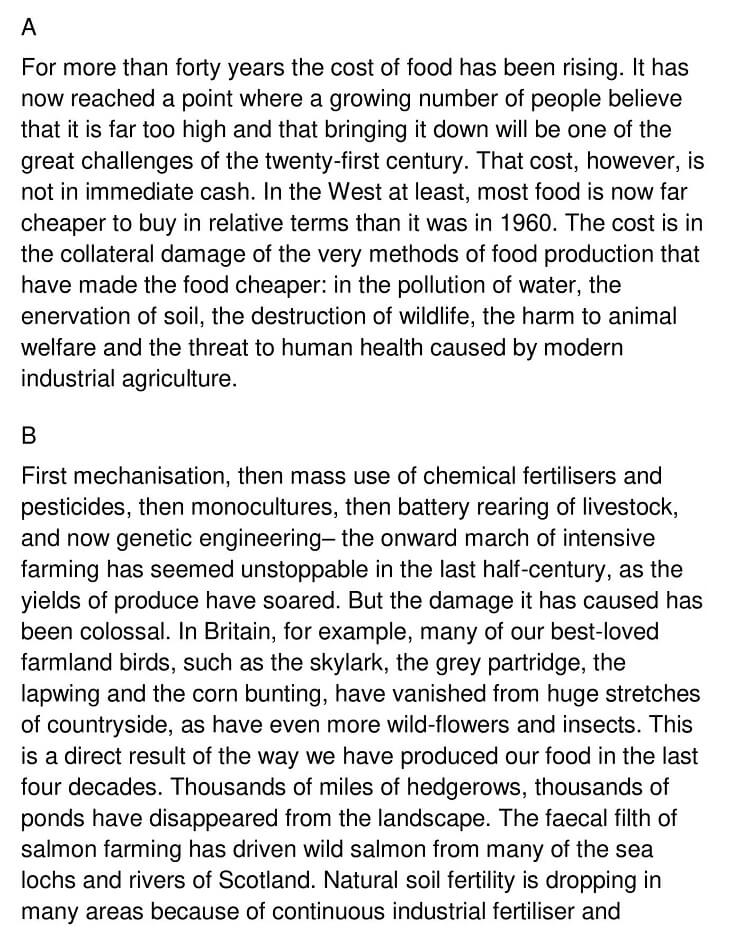
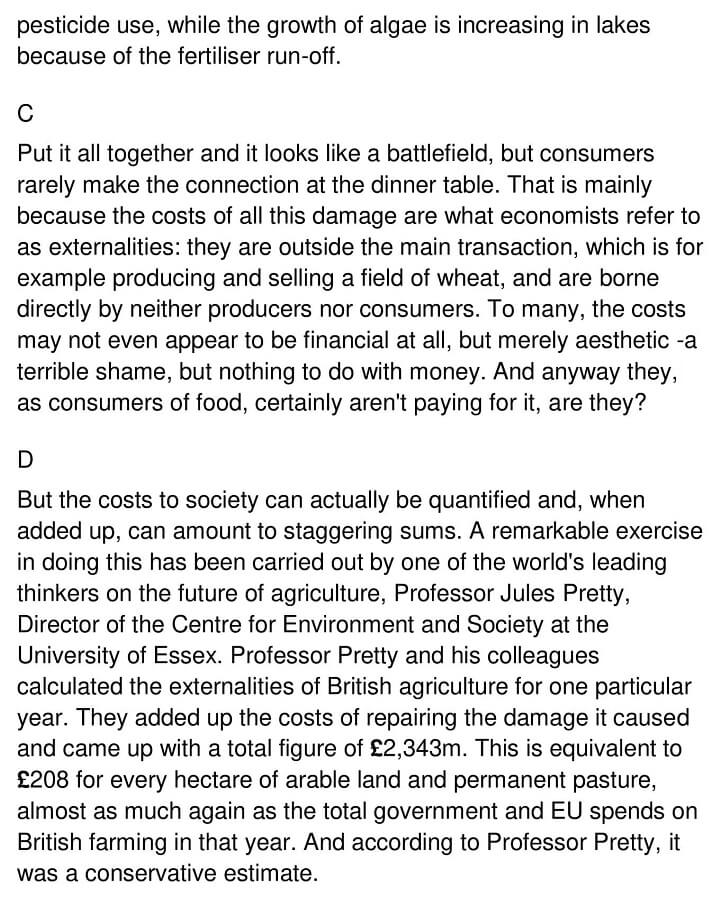
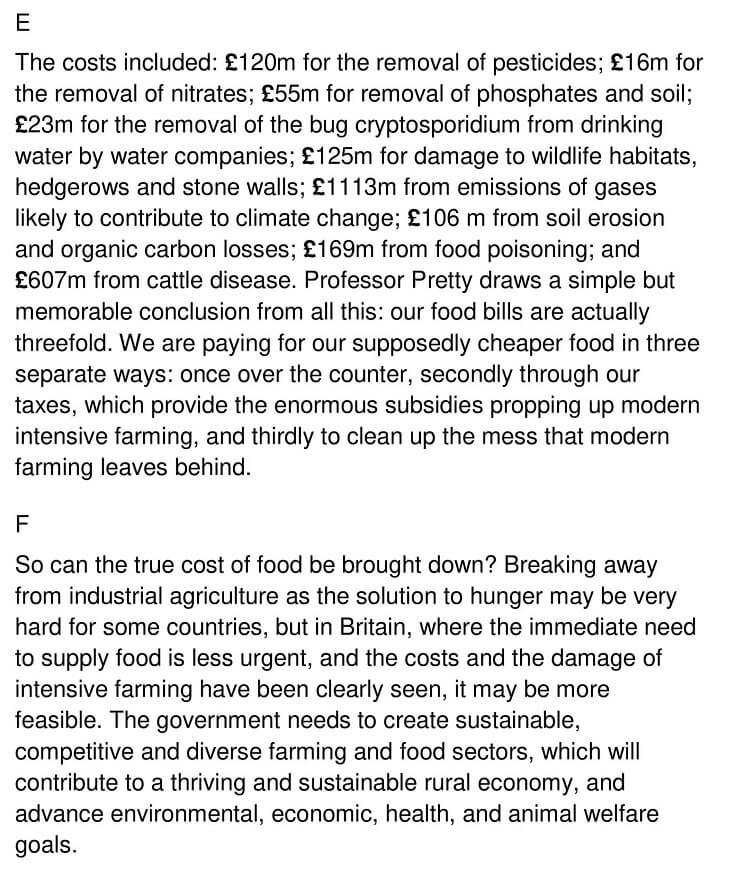
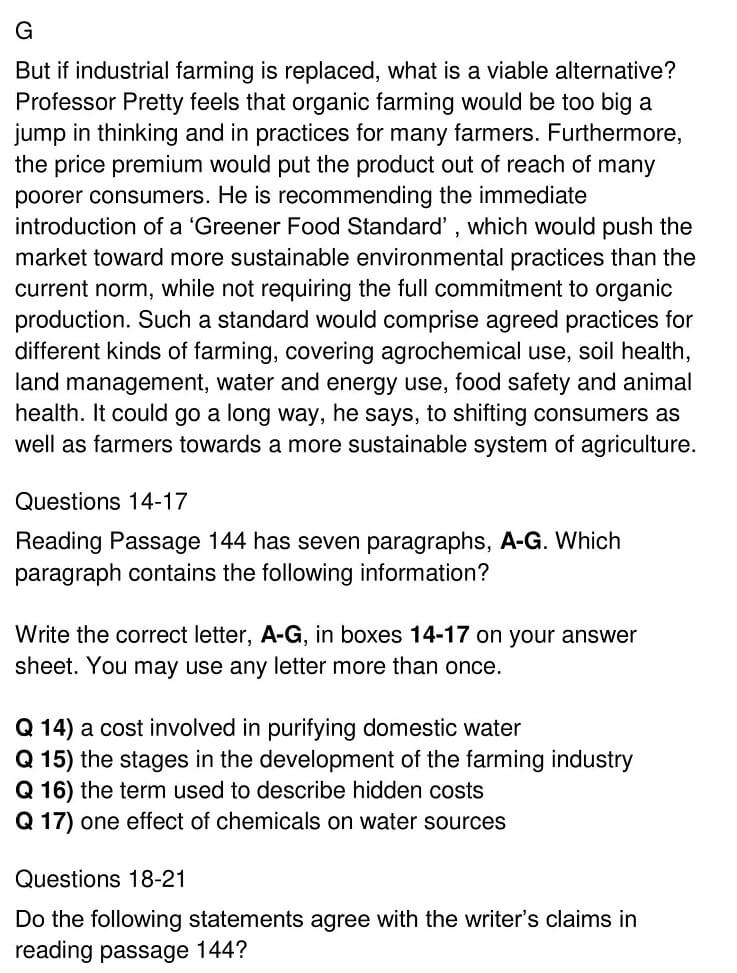
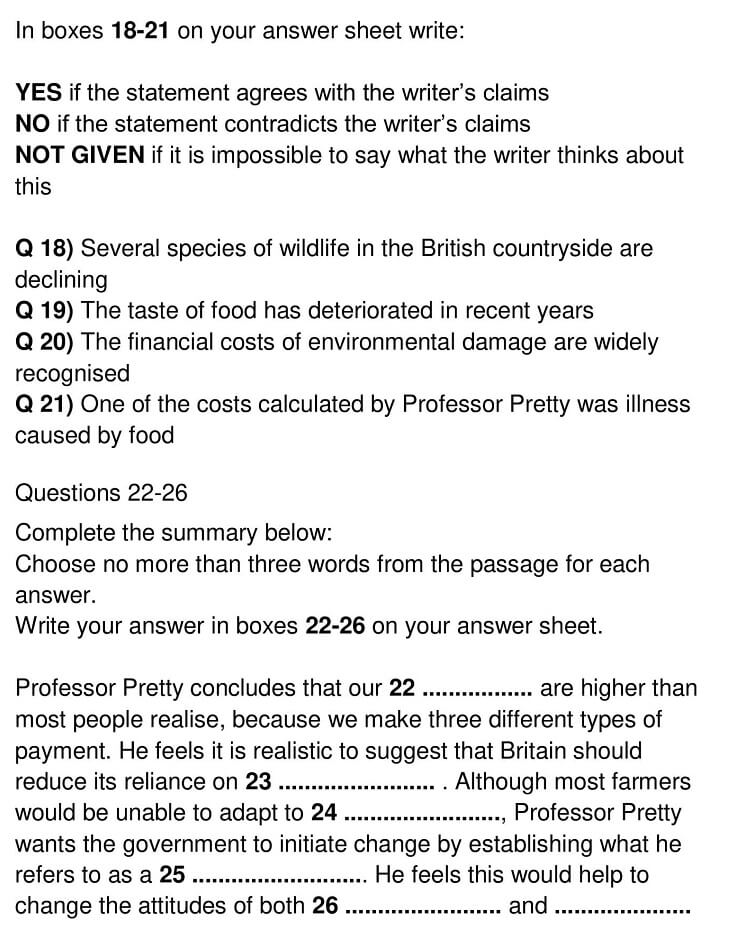
Answers
Unlock Answers
| Question Number | Answer | Explanation |
| 14 | E | In paragraph E, it is mentioned that £23m (cost) will be needed to ‘remove bug cryptosporidium’, which is a tiny, one-celled parasite causing an illness, ‘from drinking water by water companies’ (purifying). So, after the parasites are removed, the water will be clean and ready to use in homes (domestic water’). |
| 15 | B | In the first sentence of paragraph B, certain processes related to farming –‘First, mechanisation, then mass use of chemical fertilisers, then monocultures, then battery rearing of livestock, and now genetic engineering’ (stages)- are mentioned -. Moreover, the increase (‘soared’) in ‘yields of produce’ and ‘onward march of intensive farming’ asserts that it is a process of ‘development’. |
| 16 | C | In paragraph C, the writer states that economists refer to the cost of all damages ‘outside the main transaction’ as externalities (term) and are ‘borne directly by neither producers nor consumers’. It is further added that the costs ‘may not even appear to be financial at all’ (hidden cost). Therefore, externalities is the term used to describe hidden costs. |
| 17 | B | In the last sentence of paragraph B, it is mentioned that the ‘growth of algae’ (one effect) is increasing ‘in lakes’ (water source) due to ‘the fertilizer run-off’ (chemicals). So, the rapid increase of the algal population in water resources, also known as algal bloom, is one of the effects of the use of chemicals like fertilizers and pesticides on different water sources like rivers and lakes. |
| 18 | YES | In the third sentence of paragraph B, the writer states that Britain had lost (declined) several species of their best ‘birds, such as the skylark, the grey partridge, the lapwing and the corn banting’ (species of wildlife) which were found in the open areas of the land away from towns and cities (‘countryside’). Therefore, the statement agrees with the author’s claim. |
| 19 | NOT GIVEN | In paragraph A, the main discussion is about how ‘the cost of food has been rising’ for more than forty years, and so ‘one of the great challenges of the twenty-first century’ is to bring it down. This discussion leads to the ‘collateral damage’ of the methods of food production that gradually made the food cheaper, which is discussed in the next four paragraphs. Finally, in the last two paragraphs, F and G, the writer points out the views of Professor Pretty and informs that if the government introduces the ‘Greener Food Standard’, it will be helpful for the farmers (producer), consumers as well as the environment. Therefore, no views have been given on ‘the taste of food has deteriorated in recent years’ in the passage. |
| 20 | NO | In paragraph C, the writer says that the cost of ‘all these damages’ (effects of urbanization of farming like declining numbers of wildlife like skylark, pollution of water sources caused by algae due to fertilizer run-off, driving away of wild salmon from the sea and decrease in fertility of land are mentioned in the paragraph B) are ‘outside the main transaction’. It means that neither the producer nor the consumer pay it directly. These costs, referred to as ‘externalities’ by economists, may ‘not even appear to be financial at all’. The writer adds that it is a ‘terrible shame’ that these costs ‘had nothing to do with money’. Therefore,the writer wants to say that these financial costs are hidden costs and are not widely recognised. Therefore, the statement does not agree with the author’s claim. |
| 21 | YES | In paragraph D, it is mentioned that Professor Jules Pretty,one of the world’s leading thinkers on the future of agriculture, had calculated the externalities of British agriculture for one year. In that list given in paragraph E, he had mentioned that the cost from illness caused by food (‘food poisoning’) is £169m (cost). Therefore, the statement agrees with the author’s claim. |
| 22 | Food bills/costs | After presenting a list made by Jules Pretty in paragraph E, the writer adds Pretty’s ‘small but memorable’ conclusion that our ‘food bills are actually threefold’ (higher than most people realise). It is because we pay thrice for ‘supposedly cheaper food’- ‘once over the counter, secondly through our taxes, … and thirdly to clean up the mess that modern farming leaves behind’ (three different times). Hence, the answer is food bills or hidden ‘cost’ (externalities) of repairing the damage caused by farming. |
| 23 | (modern) intensive farming | In paragraph F, the writer states that after estimating the ‘the cost and damage caused by intensive farming’, Pretty thinks it is realistic (‘feasible’) to suggest that Britain should be ‘breaking away’ (reduce) from its dependence (reliance) on ‘industrial agriculture’ (modern intensive farming) as Britain’s ‘immediate need to supply food is less urgent’ compared to other countries. Hence, the answer is intensive farming. |
| 24 | Organic farming | In the beginning of paragraph G, it is suggested that organic farming can be a ‘viable alternative’ if industrial farming is replaced. But Pretty feels that the new option, ‘organic farming’, will be ‘too big a jump in thinking and in practices’ (‘unable to adapt’) for the farmers as they will be new to changes caused by organic farming. Hence, the answer is organic farming. |
| 25 | Greener Food Standard | In paragraph G, it is mentioned that as the introduction of organic farming may be too much for the farmer to work on, Pretty suggests (‘recommending’) that the government should make an ‘immediate introduction’ (initiate change) of a ‘Greener Food Standard’. It would ‘push the market towards more sustainable environmental practices’ compared to intensive farming and it does not have the ‘full commitment’ of organic farming. So, the ‘Greener Food Standard’ will be a good option towards sustainability and the government should introduce it as soon as possible. Hence, the answer is Greener Food Standard. |
| 26 | Farmers and consumers | In the last two lines of paragraph G, it is mentioned that Pretty feels that the if the government introduces the Greener Food Standard and the farmers undertakes the ‘agreed practices for different kinds of farming, covering agrochemical use, soil health, land management, water and energy use and food safety and animal safety’, then the standard would ‘go a long way’ and help in ‘shifting consumers as well as farmers towards a more sustainable system of agriculture’ (change in attitude). Hence, the answer is farmers and consumers. |
Check More IELTS Reading Answers
Also check :
Practice IELTS Reading based on question types

Start Preparing for IELTS: Get Your 10-Day Study Plan Today!
Recent Articles

Nehasri Ravishenbagam

Haniya Yashfeen

Haniya Yashfeen

Haniya Yashfeen
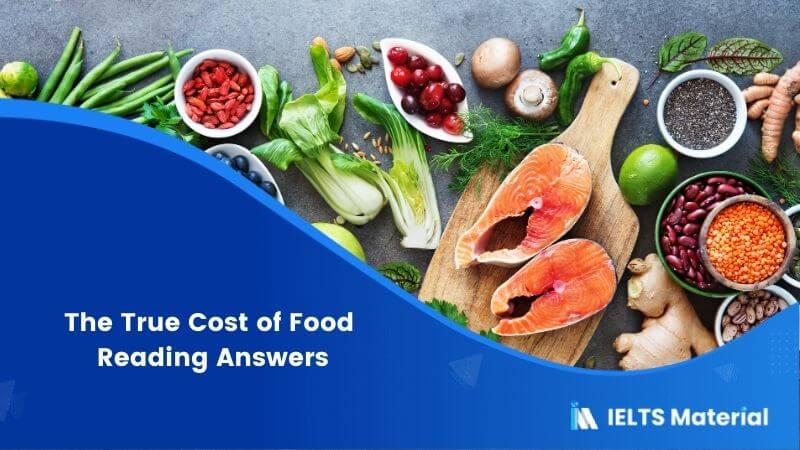



Post your Comments